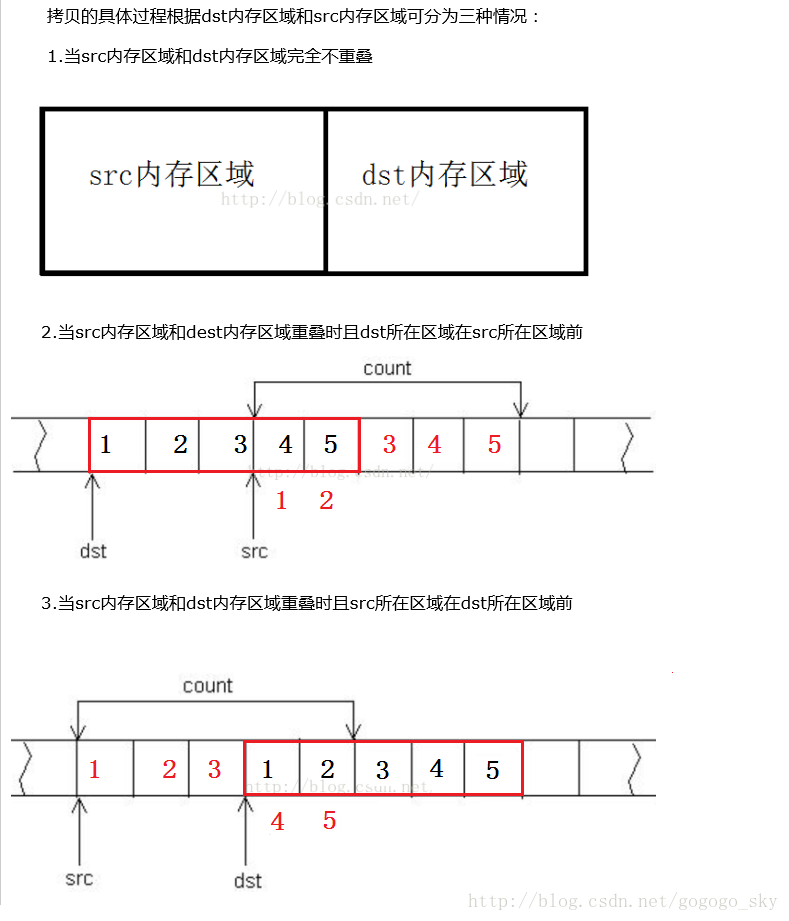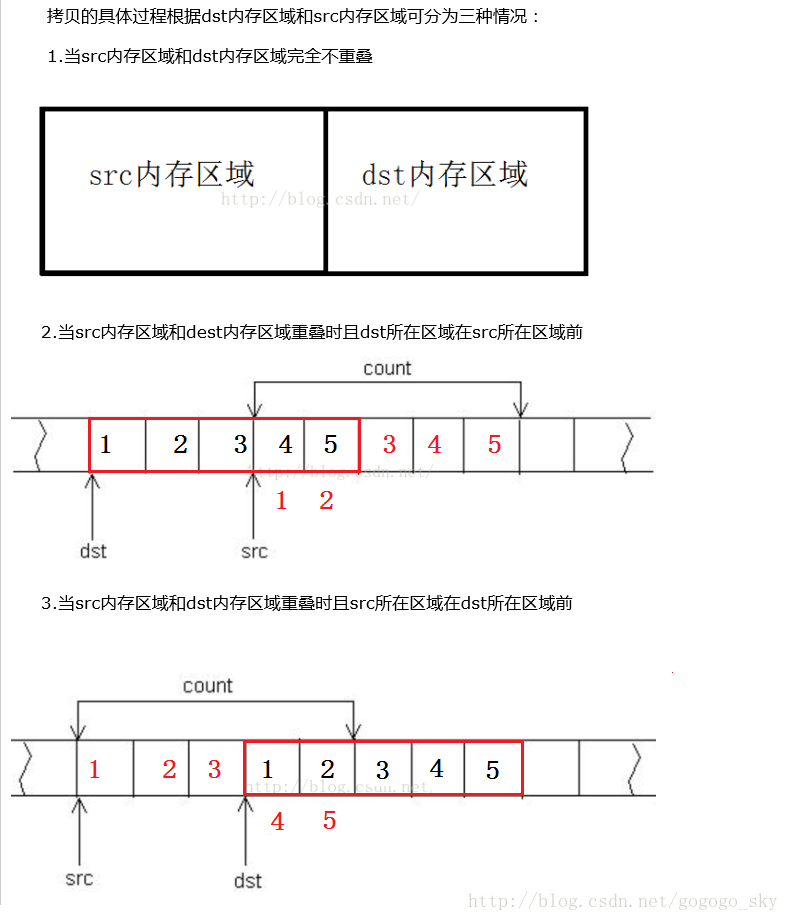strcpy&memcpy&memmove
strcpy
extern char *strcpy(char *dest,char *source);
{
assert((dest!=NULL)&&(source!=NULL));
char *address=dest;
while((*dest++=*source++)!='\0');
return address;
}
把source所指由NULL结束的字符串复制到dest所指的数组中。source和dest所指内存区域不可以重叠且dest必须有足够的空间来容纳source的字符串。返回指向dest的指针。
memcpy
void *memcpy(void *dest, const void *source, size_t count)//没有对内存重叠进行检查
{
assert((dest!=NULL)&&(source!=NULL));
char* tmpDest=(char*)dest;
char* tmpSource=(const char*)source;
while(count--)
*tmpDest++=*tmpSource++;
return tmpDest;
}
memmove
Copies the values of num bytes from the location pointed by source to the memory block pointed by destination. Copying takes place as if an intermediate buffer were used, allowing the destination and source to overlap

void* memmove(void* dest,const void* src,size_t num)
{
assert((dest!=NULL)&&(src!=NULL));
char* tmpDest=(char*)dest;
char* tmpSrc=(const char*)src;
if(src>dest||src+num<dest)
{
while(num--)
*tmpDest++=*tmpSrc++;
}
else
{
tmpDest=dest+num-;
tmpSrc=src+num-;
while(num--)
*tmpDest--=*tmpSrc--;
}
return dest;
}

strcpy&memcpy&memmove的更多相关文章
- strcpy,memcpy,memmove和内存重叠分析
一:strcpy函数用法和实现: /* GNU-C中的实现(节选): */ char* strcpy(char *d, const char *s) { char *r=d; while((*d++= ...
- strcpy, mencpy, memmove三者区别
首先来看strcpy,目的是实现字符串的复制,这里需要注意几个点: 1.判断指针的有效性 2.将复制后的指针地址返回,为了支持链式操作 3.不要忘记将字符串最后一个自负'\0'复制给dest 4.注意 ...
- 自己实现的库函数2(memset,memcmp,memcpy,memmove)
memset,memcmp,memcpy,memmove是对内存进行管理的库函数,为了更好的理解和使用这几个函数,自己用C语言实现一下~ //内存设置函数void* my_memset(void* d ...
- memset memcmp memcpy memmove 自己实现
memset memcmp memcpy memmove 自己实现 memset #include <stdio.h> #include <memory.h> #include ...
- memcpy/memmove?快速乘?
memcpy?memmove? //#pragma GCC optimize(2) #include<bits/stdc++.h> using namespace std; ; ],b[n ...
- C的memset,memcpy,strcpy 的区别 及memset memcpy memmove源码
extern void *memcpy(void *dest,void *src,unsigned int count);#include <string.h> 功能:由src所指内存 ...
- strcpy和memcpy,memmove函数的区别
strcpy和memcpy的区别 strcpy和memcpy都是标准C库函数,它们有下面的特点. strcpy提供了字符串的复制.即strcpy只用于字符串复制,并且它不仅复制字符串内容之外,还会复制 ...
- strcpy, memcpy, memset函数
一. strcpy函数 原型声明:char *strcpy(char* dest, const char *src); 头文件:#include <string.h> 和 #inclu ...
- 访谈将源代码的函数 strcpy/memcpy/atoi/kmp/quicksort
一.社论 继上一次发表了一片关于參加秋招的学弟学妹们怎样准备找工作的博客之后,反响非常大.顾在此整理一下,以便大家复习.好多源自july的这篇博客,也有非常多是我自己整理的.希望大家可以一遍一遍的写. ...
随机推荐
- day91_11_13Local与偏函数
一.local 在线程的处理中,常常遇到这样的问题.当一系列线程遇到io操作的时候,就会执行其他线程,这时候就会出现数据冲突,发生数据方面的问题: from threading import Thre ...
- navicat使用教程-PJ
navicat使用教程-PJ Navicat Keygen Patch是一款专门针对Navicat系列软件出品的一款小巧实用,功能强大的破解辅助工具.它能够实现对Navicat全系列版本进行激活破解, ...
- redhat 安装 oracle中途遇到的问题(1)
(1)安装到68%时出现弹出框 Error in invoking target 'install' of makefile '/home/oracle/app/oracle/product/11.2 ...
- SQL查询--内连接、外连接、自连接查询
先创建2个表:学生表和教师表 1.内连接: 在每个表中找出符合条件的共有记录.[x inner join y on...] 第一种写法:只用where SELECT t.TEACHER_NAME, ...
- DirectShow 常用函数总结
本文准备总结一些 Direct Show 常用的API接口函数,方便以后查询回忆.如果这里没有你想了解的函数,你可以自行搜索MSDN + 函数名去 MSDN 查找你想要了解的函数,也可以查看百度百科相 ...
- IT兄弟连 Java语法教程 流程控制语句 循环结构语句3
while循环 Java中的另外一种循环是while循环.while循环的语法格式如下: while(条件表达式){ 循环体; } 其中条件表达式定义了控制循环的条件,可以使任何有效的boolean表 ...
- 搞定Junit单元测试{非专业}
1:测试分类 2:常用测试方法 2.1 断言语句 3: 基本测试 4: 组合测试 5:参数化测试 6:分类测试(Category) 1:测试分类 1. 黑盒测试:不需要写代码,给输入值,看程序是否能 ...
- Nginx 极简教程(快速入门)
作者:dunwu github.com/dunwu/nginx-tutorial 推荐阅读(点击即可跳转阅读) 1. SpringBoot内容聚合 2. 面试题内容聚合 3. 设计模式内容聚合 4. ...
- Zabbix 预警问题-预警对应的用户报警媒介收不到
问题背景 公司现在有这种需求,需要我们对关键的预警发送到对应的项目组负责人,比如 保险项目组的服务器预警大于警告的预警发送到保险负责人的邮箱(也会发送给运维的,背锅逃不掉的). 进行创建一个 用户群组 ...
- java高并发系列 - 第8天:线程组
线程组 我们可以把线程归属到某个线程组中,线程组可以包含多个线程以及线程组,线程和线程组组成了父子关系,是个树形结构,如下图: 使用线程组可以方便管理线程,线程组提供了一些方法方便方便我们管理线程. ...
